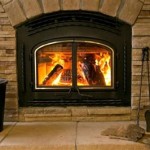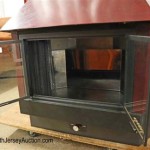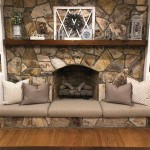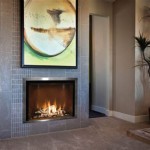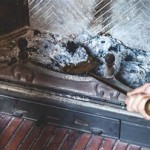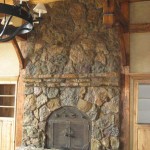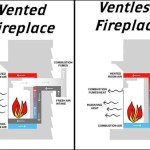Converting To Gas Fireplace Logs: A Comprehensive Guide
The allure of a crackling fire on a cold evening is undeniable. However, the mess and maintenance associated with traditional wood-burning fireplaces can be a significant deterrent. Converting to gas fireplace logs offers a convenient and cleaner alternative, providing the ambiance of a real fire without the hassle of chopping wood, storing logs, and cleaning up ashes. This article provides a comprehensive overview of the conversion process, exploring the different types of gas logs, the installation requirements, and the safety considerations involved.
Gas fireplace logs are designed to mimic the appearance of real wood, often crafted from ceramic or refractory cement. These materials are heat-resistant and durable, capable of withstanding the high temperatures generated by the gas flame. The logs are strategically arranged within the fireplace to create a realistic and visually appealing flame pattern. Beyond aesthetics, gas logs offer a practical heating solution, providing supplemental warmth to a room with the simple flick of a switch or the press of a remote control button.
Before embarking on the conversion process, it is crucial to understand the various types of gas logs available and the specific requirements of one’s existing fireplace. Careful planning and adherence to safety guidelines are paramount to ensure a successful and safe installation.
Understanding the Types of Gas Fireplace Logs
Gas fireplace logs are generally categorized into two main types: vented and vent-free (or ventless). Each type operates differently and has distinct advantages and disadvantages. Making an informed decision about which type to choose is essential for optimal performance and safety.
Vented Gas Logs: Vented gas logs are designed to be used in a fully functional, open-flue fireplace. They require a working chimney or vent to exhaust combustion byproducts, such as carbon monoxide, outside of the home. These logs produce a more realistic flame appearance, often mirroring the flickering and dancing flames of a traditional wood-burning fire. They also tend to generate less radiant heat compared to vent-free models, as much of the heat escapes up the chimney with the exhaust gases. Vented logs are typically more aesthetically pleasing but less efficient as a heating source.
The installation of vented gas logs typically involves placing the logs on a grate inside the fireplace and connecting them to a gas supply line. The damper must remain open during operation to allow for proper ventilation. Because they rely on the chimney for ventilation, vented gas logs are less susceptible to causing indoor air quality concerns related to carbon monoxide buildup, provided the chimney is properly maintained and free from obstructions.
Vent-Free Gas Logs: Vent-free gas logs, as the name suggests, do not require a chimney or vent for operation. They burn gas more efficiently and completely, minimizing the production of carbon monoxide and other harmful emissions. These logs are equipped with oxygen depletion sensors (ODS) that automatically shut off the gas supply if the oxygen level in the room drops to an unsafe level. Vent-free logs are designed to provide supplemental heat to a specific area and are often more energy-efficient than vented models.
While vent-free logs offer convenience and efficiency, they also require careful consideration of safety. They should only be used in well-ventilated rooms and in fireplaces that meet specific size and construction requirements. Regular maintenance, including cleaning the logs and checking the ODS, is crucial for safe operation. Furthermore, some individuals may be sensitive to the slight odor produced by vent-free gas logs, although most modern models are designed to minimize this.
The choice between vented and vent-free gas logs depends on individual preferences, budget, fireplace configuration, and heating needs. Consulting with a qualified HVAC technician or fireplace professional is recommended to determine the most suitable option for a specific situation.
Preparing Your Fireplace for Gas Log Installation
Before installing gas logs, it is essential to prepare the fireplace thoroughly. This involves cleaning the firebox, inspecting the chimney (if applicable), and ensuring that the gas supply line is properly installed and sized. Neglecting these preparatory steps can lead to safety hazards and operational problems.
Cleaning and Inspection: Begin by removing all existing ashes, debris, and soot from the firebox. A thorough cleaning will improve the appearance of the fireplace and prevent any potential interference with the gas log installation. Next, inspect the firebox for any cracks, damage, or deterioration. Repairing any structural issues before proceeding is crucial to ensure the integrity of the fireplace. If converting to vented gas logs, inspect the chimney for obstructions, such as bird nests or fallen debris. A professional chimney sweep can perform a comprehensive inspection and cleaning to ensure proper ventilation.
Gas Supply Line Installation: A gas supply line is necessary to provide fuel to the gas logs. If a gas line is not already present, a qualified plumber or gas technician must install one. The gas line should be properly sized to accommodate the gas log unit's BTU (British Thermal Unit) requirements. It is imperative to adhere to all local codes and regulations when installing a gas line. A shut-off valve should be installed near the fireplace to allow for easy disconnection in case of emergency or maintenance. The gas line must be properly leak-tested to ensure there are no gas leaks. A soapy water solution can be applied to the gas line connections; bubbles indicate a leak that needs immediate attention.
Fireplace Dimensions and Clearance: Measure the dimensions of the firebox to ensure that the gas logs will fit properly. The logs should not be too large, as this can restrict airflow and create a safety hazard. Check the manufacturer's specifications for recommended clearances from the fireplace walls and other combustible materials. Maintaining adequate clearance is essential to prevent overheating and potential fires. If using vent-free logs, ensure that the fireplace meets the minimum size requirements specified by the manufacturer. These requirements are designed to ensure adequate ventilation and prevent carbon monoxide buildup.
Proper preparation is the foundation for a successful and safe gas log conversion. Taking the time to thoroughly clean, inspect, and prepare the fireplace will minimize potential problems and ensure optimal performance of the gas logs.
Installing Gas Fireplace Logs: A Step-by-Step Guide
The installation process for gas fireplace logs varies slightly depending on whether vented or vent-free logs are being installed. However, the basic principles remain the same: ensuring proper placement, connection to the gas supply, and functionality testing. Following the manufacturer's instructions carefully is crucial for a safe and effective installation.
Unpacking and Placement: Carefully unpack the gas logs and other components, such as the grate, burner assembly, and remote control (if applicable). Inspect all parts for damage or defects. Refer to the manufacturer's instructions for the recommended log placement configuration. Gas logs are designed to be arranged in a specific pattern to create a realistic flame appearance and ensure proper airflow. Place the grate inside the firebox, ensuring that it is level and stable. Position the burner assembly on the grate, aligning it with the gas supply line connection.
Connecting to the Gas Supply: Connect the gas supply line to the burner assembly using the appropriate fittings. Ensure that the connection is tight and secure to prevent gas leaks. Use pipe sealant or Teflon tape on the threads to create a gas-tight seal. Double-check all connections to ensure they are properly tightened. After connecting the gas supply, perform a leak test using a soapy water solution. Apply the solution to all connections and look for bubbles. If bubbles are present, tighten the connection until the leak is eliminated. Do not proceed with the installation until all leaks are resolved.
Arranging the Logs: Carefully arrange the gas logs according to the manufacturer's instructions. The logs should be positioned around the burner assembly in a way that allows for proper airflow and creates a realistic flame pattern. Avoid blocking the burner ports or obstructing the pilot light. Ensure that the logs are stable and will not shift or fall during operation. The placement of the logs significantly impacts the flame appearance and heat output. Experiment with different arrangements until the desired effect is achieved while adhering to the manufacturer's guidelines.
Testing and Safety Checks: After completing the installation, perform a thorough test of the gas logs. Turn on the gas supply and light the pilot light according to the manufacturer's instructions. Observe the flame pattern to ensure that it is consistent and realistic. Check for any unusual odors or noises. If a remote control is included, test its functionality to ensure that it properly controls the flame height and on/off operation. For vent-free logs, verify that the oxygen depletion sensor (ODS) is functioning correctly. This can be done by partially obstructing the sensor with a piece of cardboard and observing whether the gas shuts off automatically after a short period.
If any problems are encountered during the installation or testing process, consult the manufacturer's troubleshooting guide or contact a qualified HVAC technician or fireplace professional for assistance. Never attempt to repair gas appliances unless properly trained and qualified.

Wood Fireplaces Gas Conversion That Counts

Can A Wood Burning Fireplace Be Converted To Gas The Flame Company

Convert To Gas Installing Fireplace Inserts Doctor Flue

Wood Fireplace To Gas Logs Conversion Mad Hatter Services

Chicago Gas Fireplace Logs Conversion Installation

Wood To Gas Fireplace Conversion In Wisconsin Free Quote Badgerland Waesha

How To Modernize And Update A Gas Fireplace We Love Fire

Want To Convert Gas Wood Fireplace Full Service Chimney

Want To Convert Gas Wood Fireplace Full Service Chimney

Logs Vs Inserts Convert Your Fireplace From Wood To Gas
Related Posts

